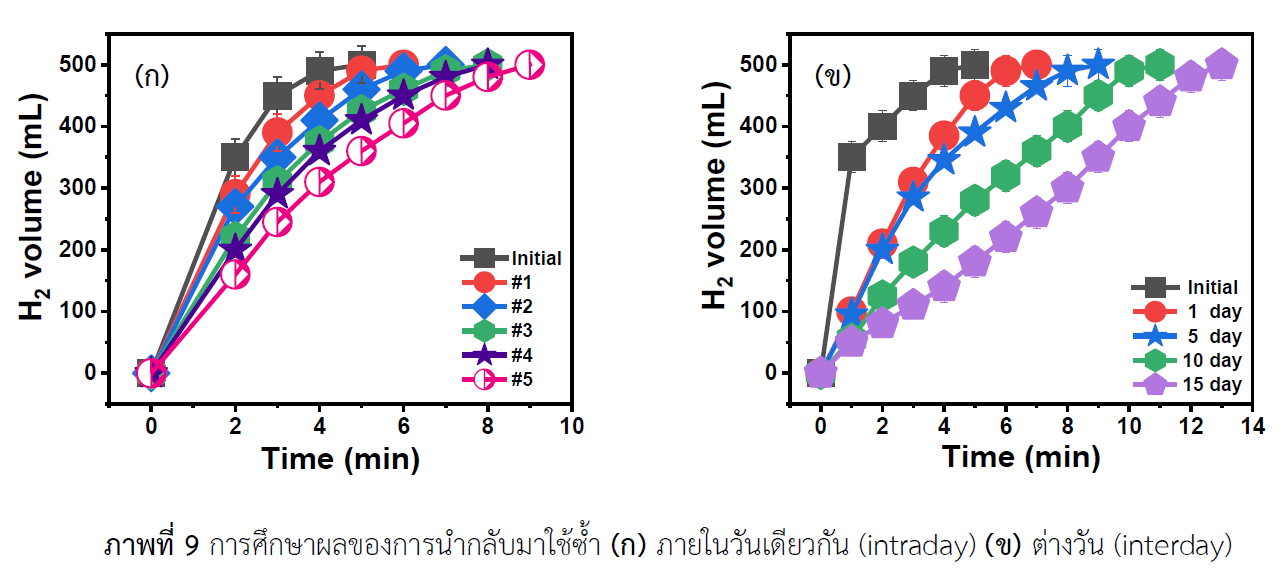ไฮโดรเจลพอลิเมอร์ผสม(2-อะคริลามิโด-2-เมทิลโพรเพนซัลโฟนิค เอซิด-อะคลิลิค เอซิด) รองรับอนุภาคคอปเปอร์ระดับนาโนและการใช้ประโยชน์เป็นตัวเร่งปฏิกิริยาสำหรับการผลิตแก๊สไฮโดรเจนจากปฏิกิริยาการย่อยสลายน้ำด้วยโซเดียมโบโรไฮไดรด์
Main Article Content
บทคัดย่อ
ในงานวิจัยนี้ ไฮโดรเจลพอลิเมอร์ผสมที่มาจาก 2-อะคริลามิโด-2-เมทิลโพรเพนซัลโฟนิค เอซิด กับ อะคลิลิค เอซิด ด้วยอัตราส่วนต่าง ๆ สามารถสังเคราะห์ขึ้นได้โดยอาศัยปฏิกิริยาฟรีแรดิคอลพอลิเมอไรเซชันเพื่อใช้ในการดูดซับไอออนคอปเปอร์ด้วยหมู่ฟังก์ชันที่มีอยู่ภายในโครงร่างข่ายไฮโดรเจล หลังจากนั้น ไอออนคอปเปอร์ที่ถูกตรึงภายในโครงสร้างไฮโดรเจลถูกเปลี่ยนให้เป็นอนุภาคคอปเปอร์ระดับนาโนโดยอาศัยปฏิกิริยารีดักชันจากการใช้โซเดียมโบโรไฮไดรด์ทำหน้าที่เป็นตัวรีดิวซ์ ศึกษาการบวมตัวของไฮโดรเจล ตลอดจนวิเคราะห์อนุภาคคอปเปอร์ระดับนาโนในไฮโดรเจลพอลิเมอร์โดยอาศัยเทคนิคฟูเรียร์ทรานส์ฟอร์มอินฟราเรดสเปกโตรสโคปีและการเปลี่ยนแปลงน้ำหนักของสารโดยอาศัยคุณสมบัติทางความร้อน หลังจากนั้น ศึกษาประสิทธิภาพในการเร่งปฏิกิริยาของไฮโดรเจลพอลิเมอร์ผสมที่รองรับอนุภาคคอปเปอร์ระดับนาโนในการย่อยสลายน้ำด้วยโซเดียมโบโรไฮไดรด์สำหรับการผลิตแก๊สไฮโดรเจน คำนวณพารามิเตอร์จำเพาะของปฏิกิริยาจากสมการอาร์รีเนียสและสมการอายริงก์ ผลการคำนวณที่ได้พบว่า พลังงานก่อกัมมันต์ (Ea) มีค่า 18.20 kJ mol-1 ในขณะที่เอนทาลปีพลังงานกระตุ้นและเอนโทรปีพลังงานกระตุ้นมีค่า 20.84 kJ mol-1 และ -197.54 kJ mol-1 K-1 ตามลำดับ นอกจากนี้ ไฮโดรเจลพอลิเมอร์ผสมที่รองรับอนุภาคคอปเปอร์ระดับนาโนยังสามารถนำกลับมาใช้ใหม่ได้หลายครั้งโดยยังคงประสิทธิภาพในการเร่งปฏิกิริยา งานวิจัยนี้แสดงให้เห็นว่า ไฮโดรเจลพอลิเมอร์ผสมที่รองรับอนุภาคคอปเปอร์ระดับนาโนมีประโยชน์อย่างมากในการย่อยสลายน้ำด้วยโซเดียมโบโรไฮไดรด์สำหรับการผลิตแก๊สไฮโดรเจน รวมทั้งในการเร่งปฏิกิริยาอื่น ๆ ที่น่าสนใจ
Article Details

อนุญาตภายใต้เงื่อนไข Creative Commons Attribution-NonCommercial-NoDerivatives 4.0 International License.
วารสารวิทยาศาสตร์และวิทยาศาสตร์ศึกษา (JSSE) เป็นผู้ถือลิสิทธิ์บทความทุกบทความที่เผยแพร่ใน JSSE นี้ ทั้งนี้ ผู้เขียนจะต้องส่งแบบโอนลิขสิทธิ์บทความฉบับที่มีรายมือชื่อของผู้เขียนหลักหรือผู้ที่ได้รับมอบอำนาจแทนผู้เขียนทุกนให้กับ JSSE ก่อนที่บทความจะมีการเผยแพร่ผ่านเว็บไซต์ของวารสาร
แบบโอนลิขสิทธิ์บทความ (Copyright Transfer Form)
ทางวารสาร JSSE ได้กำหนดให้มีการกรอกแบบโอนลิขสิทธิ์บทความให้ครบถ้วนและส่งมายังกองบรรณาธิการในข้อมูลเสริม (supplementary data) พร้อมกับนิพนธ์ต้นฉบับ (manuscript) ที่ส่งมาขอรับการตีพิมพ์ ทั้งนี้ ผู้เขียนหลัก (corresponding authors) หรือผู้รับมอบอำนาจ (ในฐานะตัวแทนของผู้เขียนทุกคน) สามารถดำเนินการโอนลิขสิทธิ์บทความแทนผู้เขียนทั้งหมดได้ ซึ่งสามารถอัพโหลดไฟล์บทความต้นฉบับ (Manuscript) และไฟล์แบบโอนลิขสิทธิ์บทความ (Copyright Transfer Form) ในเมนู “Upload Submission” ดังนี้
1. อัพโหลดไฟล์บทความต้นฉบับ (Manuscript) ในเมนูย่อย Article Component > Article Text
2. อัพโหลดไฟล์แบบโอนลิขสิทธิ์บทความ (Copyright Transfer Form) ในเมนูย่อย Article Component > Other
ดาวน์โหลด ไฟล์แบบโอนลิขสิทธิ์บทความ (Copyright Transfer Form)
เอกสารอ้างอิง
Ayub, I., Munir, A., Amjad, W., Ghafoor, A. and Nasir, M. S. (2018). Energy- and exergy-based thermal analyses of a solar bakery unit. Journal of Thermal Analysis and Calorimetry, 133, 1001-1013.
Bao, Y., Ma, J. and Li, N. (2011). Synthesis and swelling behaviors of sodium carboxymethyl cellulose-g-poly (AA-co-AM-co-AMPS)/MMT superabsorbent hydrogel. Carbohydrate Polymers. 84(1),76-82.
Cao, H., Duan, L., Zhang, Y., Cao, J. and Zhang, K. (2021). Current hydrogel advances in physicochemical and biological response-driven biomedical application diversity. Signal transduction and targeted therapy. 6(1), 426.
Ding, J., Li, Q., Su, Y., Yue, Q., Gao, B. and Zhou, W. (2018). Preparation and catalytic activity of wheat straw cellulose based hydrogel-nanometal composites for hydrogen generation from NaBH4 hydrolysis. International Journal of Hydrogen Energy. 43(21), 9978-9987.
Engin, M., and Ozay, O. (2018). The first catalytic hydrolysis of ethylenediamine bisborane with hydrogel-supported metallic nanoparticles. International Journal of Hydrogen Energy. 43(32), 15083-15094.
Güven, O., Demirci, S., Sütekin, S. D., Ari, B. and Sahiner, N. (2022). P(HMA-co-ATU) hydrogel synthesis via gamma radiation and its use for in situ metal nanoparticle preparation and as catalyst in 4-nitrophenol reduction. Radiation Physics and Chemistry, 198, 110217.
Khan, S. B., Ali, F. and Asiri, A. M. (2020). Metal nanoparticles supported on polyacrylamide water beads as catalyst for efficient generation of H2 from NaBH4 methanolysis. International Journal of Hydrogen Energy, 45(3), 1532-1540.
Kojima, Y. (2019). Hydrogen storage materials for hydrogen and energy carriers. International Journal of Hydrogen Energy, 44(33), 18179-18192.
Le, T. T., Pistidda, C., Nguyen, V. H., Singh, P., Raizada, P., Klassen, T. and Dornheim, M. (2021). Nanoconfinement effects on hydrogen storage properties of MgH2 and LiBH4. International Journal of Hydrogen Energy, 46(46), 23723-23736.
Liao, J. and Huang, H. (2020). Magnetic sensitive Hericium erinaceus residue chitin/Cu hydrogel nanocomposites for H2 generation by catalyzing NaBH4 hydrolysis. Carbohydrate polymers. 229, 115426.
Liu, K., Qin, R. and Zheng, N. (2021). Insights into the interfacial effects in heterogeneous metal nanocatalysts toward selective hydrogenation. Journal of the American Chemical Society, 143(12), 4483-4499.
Mahmoud, G. A. (2014). Radiation synthesis of hydrogels as carriers for catalytic nanoparticles and their use in hydrogen production from sodium borohydride. Monatshefte für Chemie-Chemical Monthly, 145, 711-720.
Saeed, A. M. (2013). Temperature effect on swelling properties of commercial polyacrylic acid hydrogel beads. International Journal of Advanced Biological and Biomedical Research, 1(12), 1614-1627.
Sahiner, N. and Seven, F. (2015). The use of superporous p(AAc (acrylic acid)) cryogels as support for Co and Ni nanoparticle preparation and as reactor in H2 production from sodium borohydride hydrolysis. Energy, 71(15), 2014, 170-179.
Sun, Y., Tian, P., Ding, D., Yang, Z., Wang, W., Xin, H., Xu, J. and Han, Y-F. (2019). Revealing the active species of Cu-based catalysts for heterogeneous Fenton reaction. Applied Catalysis B: Environmental. 258, 117985
Ullah, N., Ullah, A and Rasheed, S. (2020). Green synthesis of copper nanoparticles using extract of Dicliptera Roxburghiana, their characterization and photocatalytic activity against methylene blue degradation. Letters in Applied NanoBioScience, 9, 897-901.
Wan, J., Chen, L., Li, Q., Ye, Y., Feng, X., Zhou, A., Long, X., Xia, D. and Zhang, T. C. (2020). A novel hydrogel for highly efficient adsorption of Cu(II): synthesis, characterization, and mechanisms. Environmental Science and Pollution Research, 27, 26621-26630.
Yildiz, S., Nahit A. and Sahiner, N. (2014). Metal nanoparticle-embedded super porous poly (3-sulfopropyl methacrylate) cryogel for H2 production from chemical hydride hydrolysis. International journal of hydrogen energy, 39(27), 14690-14700.
Zhao, L., Li, Q., Su, Y., Yue, Q. and Gua, B. (2017). A novel Enteromorpha based hydrogel for copper and nickel nanoparticle preparation and their use in hydrogen production as catalysts. International Journal of Hydrogen Energy, 42(10), 6746-6756.


